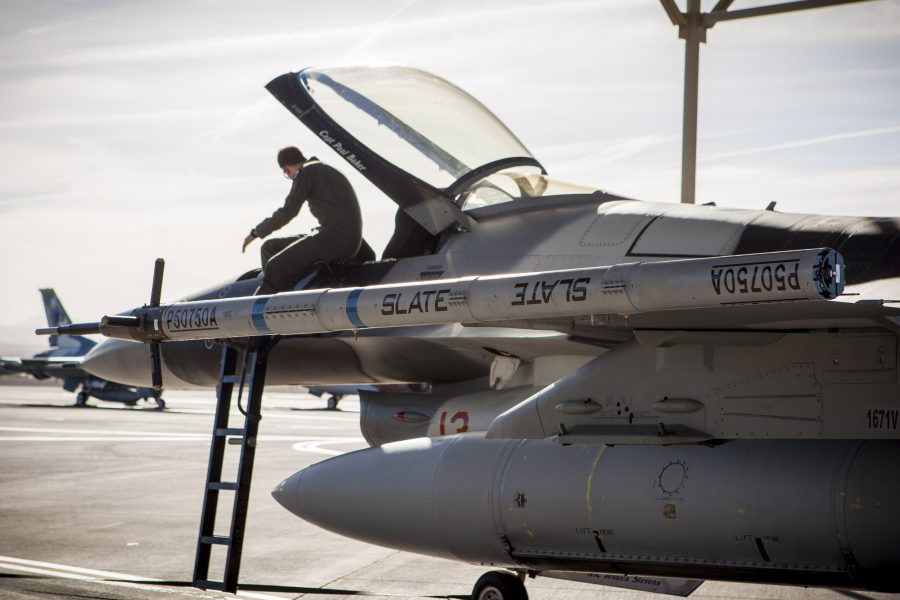Artificial intelligence and open systems can better prepare the Air Force for a potential high-end fight against the likes of China and Russia, but the Air Force has work to do to make that a reality, service officials and industry leaders said last week.
Across two panels at AFA’s Air, Space & Cyber Conference, experts said the training enterprise has made progress towards better representing the threats the U.S. will face in the future and the means to counter them. But to be effective, that training needs to be less fragmented, more open to sharing data, and adopt a faster approach to cybersecurity.
Most of the work left to do will be in the digital realm. The Air Force’s flying hour program has declined, and some of the capabilities on new systems such as the F-35 are so sensitive that training with them in the open air would risk exposure to adversaries.
“Every time we go fly, people are seeing and sniffing everything we’re doing and they’re bringing that back and informing how they think about navigating and countering our proposition for deterrence,” said Mike Benitez, director of product for Shield AI.
Combined, those factors have pushed the Air Force to emphasize simulators, said Maj. Gen. Gregory Kreuder, commander of the 19th Air Force—to the point that new F-35 pilots “are demanding that we spend more time in the sim to train the high-end fight,” he said.
Officials agreed that the quality of Air Force simulators has increased dramatically in the past few decades.
“When I joined the Air Force about 30 years ago, in the mid-90s, late-90s, the sims were crap, essentially,” Kreuder said. “They were emergency procedures training, doing some approaches on them. They were isolated. They didn’t connect to anything.”
Programs such as the F-35’s Joint Simulation Environment (JSE) and the Air Force’s Digital Test and Training Range helped the service create “a physics-based environment that has the fidelity, the realism, to actually train in that virtual environment,” said Benitez.
Yet the realism of a simulator is inherently limited in several ways.
“If I’m in a simulator, unless the building catches on fire, I’m generally not afraid that I’m going to lose my life,” noted Maj. Gen. Clark Quinn, deputy commander for Air Education and Training Command.
On top of that, “if you survey 2,000 fighter pilots, 1,999 would tell you that the adversary forces in the sim are terrible,” said Benitez.
The next step, officials said, is a blend of live, virtual, and constructive (LVC) training—constructive refers to simulated players in a training scenario who respond to the human’s actions, whether it be an adversary or a wingman. But the time for merely considering LVC training is over, experts said.
“We’re past the point of it being an imperative that we have to look at live, virtual, and constructive,” Benitez said. “It should be a foundational part of generating readiness.”
“We have to increase the value of every hour we spend in the air,” added Dan Ourada, vice president at Amentum. “Having threat replicators with live blended synthetic and live, virtual, constructive recreates the experience of a high-end fight.”
AI could play a central role helping pilots learn to work with autonomous wingmen like the forthcoming Collaborative Combat Aircraft, said Matt George, founder and CEO of Merlin Labs.
“If a human pilot is flying with a system that is a non-human pilot next to them, or flying with a Shield AI wingman on board a CCA, or flying with any other AI-enabled tool, that is dramatically different than how we train our pilots today,” George said. “So by actually getting stuff out there, learning where the gaps are, getting into the simulator, getting into flight, we could start to develop those tactics and trainings in a way that, in my opinion, we’re never going to be able to get to if we keep this at an academic level.”
Yet while Kreuder marveled that “it’s incredible where the technology’s at,” the Air Force needs a shared vision for tying it all together, industry officials said.
“The one thing that we can do better is defining a common set of pipes and a common set of infrastructure that we can all develop too, so that we can begin to develop some common ways of being able to touch those pipes with some modularity in terms of systems, intelligence, mission systems that come into those systems,” said George.
Doug Gill, senior staff scientists at FSI Defense, voiced a similar view, saying the main issue with LVC training is “it’s actually kind of fragmented.”
The Air Force has increasingly emphasized open, modular systems across new aircraft and networks, allowing for easier sharing of data. When it comes to training, though, the system is stovepiped across different programs, Gill warned. Even JSE, which provides a common platform for multiple services and partners to work together on the F-35, can be more open in sharing and incorporating data from other simulation environments, he said.
“We’re talking about a joint mission that also has Army and also has Navy and has coalition,” said Gill. “And I think JSE actually should be an open part of that system, and it’s bringing a few great new ideas in.”
AI helped make large-scale simulators a reality, processing huge amounts of data to produce more precise, realistic results. But producing more granular data while including coalition partners will test the Pentagon’s already stressed networks, said Cathy Johnston, vice president of mission integration at Peraton.
Further complicating matters is the cybersecurity risk of such systems.
“We are stopped with that risk management framework. It halts funding. It halts progress. It halts moving forward,” said Ourada. “So as we look at the fifth-, the sixth-, and seventh-generation [simulators], we have to find a better way to secure what we call open architecture, to secure data.”

